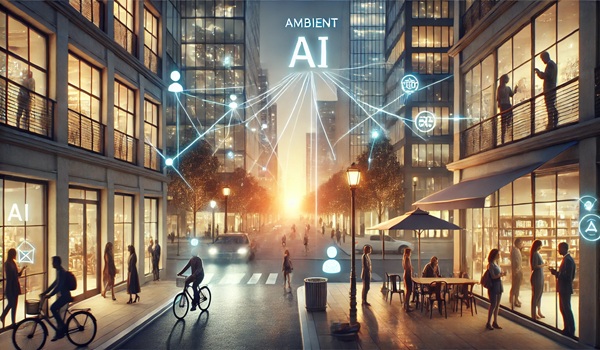Each week we find a new topic for our readers to learn about in our AI Education column.
I went to the doctor for an annual checkup recently and, well, a lot was new in the office. Different receptionist. Different diagnostic equipment. Different nursing staff members.
It was the same doctor, but the way he was working had changed—instead of spending most of our visit behind a computer keyboard inputting data and commands manually, he was having an ongoing, unprompted conversation with a virtual assistant while he was talking to me without touching the computer in the room.
He was using ambient AI.
He’s not alone, about one-in-three medical groups now use at least some type of listening ambient AI to transcribe speech and draft notes, according to the Medical Group Management Association.
Ambient AI is artificial intelligence that you don’t need to prompt directly or turn on—it activates itself when it is needed. So, in healthcare settings, it senses when a doctor and patient are together in a room and automatically begins to function without any additional action needed.
It’s AI designed in a way that you might not even know it was there, unless you were one of the people who depended on its functionality. Today, it’s primarily being used in healthcare clinical settings, but it’s also finding applications in security, defense and, you guessed it, finance.
What Is Ambient AI
The AI tools that we’re most familiar with—Claude, ChatGPT, Gemini—are active. We have to engage with them manually. We have to prompt them. We tell them what we want to do, and they do the work for us. Ambient AI isn’t like that. Ambient AI is built to anticipate what we need, when we need it, in a given environment like an office.
We’ll give more examples of what this looks like in a healthcare setting later, because this is where we have actually experienced ambient AI, but we can imagine what it means in other settings—for example, in wealth management, it could take notes of conversations, schedule appointments, prepare proposals, generate documents and then execute a financial plan, down to individual trades. Of course, the technology to do all these things already exists, but an advisor has to directly interact with the technology to make everything happen. In ambient AI, everything would occur automatically in the flow of a client discussion.
What is Ambient AI Versus Ambient.ai, Ambient Intelligence and Artificial Intelligence?
In most cases, ambient intelligence is pretty much synonymous with ambient AI. As typically used, ambient intelligence captures data unobtrusively through an environment using embedded devices—actuators and sensors—and then use that data to create seamless experiences that do not require intervention. However, ambient intelligence is also sometimes used to refer to environments built with technology designed to sense human presence and adapt accordingly—which would encompass pre-AI technology like the early “smart homes” with entertainment and climate control systems designed to follow inhabitants from room to room.
Ambient.ai is a computer vision company that uses AI to monitor and analyze security camera footage in real time in hopes of stopping and preventing crime, or at least permitting a more rapid and effective responses to security incidents.
Ambient AI is a type of artificial intelligence. So, not all ambient intelligence is AI, but all ambient AI is artificial intelligence, and some AI is ambient AI.
How Does Ambient AI Work?
Ambient AI is really a combination of technologies. In the case of my doctor’s office, the entire facility is wired with connected computers. Every staff member wears a personal tag with RFID that automatically logs them into the devices they are using, and they use those devices to scan patient bracelets, accessing the patient’s record, and automatically associating any information they record—and the words they speak—with the patient they are currently treating or visiting. All of that information is available to the patient via an online portal, instantaneously. Behind the scenes, that information can also be integrated into prescriptions, referrals to other providers and bills to insurers.
The software interacts not just in natural language, but translates medical jargon, shorthand and acronyms, even those specific to a facility or care provider. It remembers what tools and systems are used by each staff member for each stage of patient care, from registration, to triage, to diagnosis, to treatment, to discharge—and the particular order each specific staff member prefers to use those tools.
So, ambient AI uses devices networked into a given environment—currently, these are finite environments. The devices used to identify workers and clients may or may not be visible, but they are unobtrusive and are easily moved and transferred when necessary. Enabled by the AI, the devices can sense people and situations, they are adaptable and can be personalized, and can learn to anticipate the needs and preferences of their users.
A Guy Walks Into A Doctor’s Office, Continued
So we’re not going to talk about what platform my doctor used, let’s just say that it knew to put history and physical information into an area for doctor’s notes, to find the correct laboratory requisitions, to note other diagnostic studies, and to help him put together a treatment plan. The best part was that my doctor actually had enough time to look at me and talk to me because he wasn’t stuck typing during our entire brief visit.
And that’s what his health system intended when it implemented the system. The benefits of ambient AI in healthcare are supposed to be more face-to-face time with your provider. Let’s not forget that technology and insurance requirements are the two big reasons we lost all that face-to-face time with our providers in the first place, but okay, in the first part of my recent doctor’s visit, I did actually get to spend more face-to-face time with him and speak in greater detail about some of my issues and concerns—but it wasn’t all great.
The problem was that the technology didn’t always understand the nuances of healthcare notetaking and order entry, requiring him to repeat himself to the software several times, and also to have to go back into the system at the end of our visit to enter information manually. After a lovely visit, he probably spent 20 minutes battling with the technology to get the correct notes and orders in the system—and those problems cost him as much time as the system saved.
So ambient AI is here, we’re already using it in very highly regulated settings, yet it’s also still very much a work in progress.







